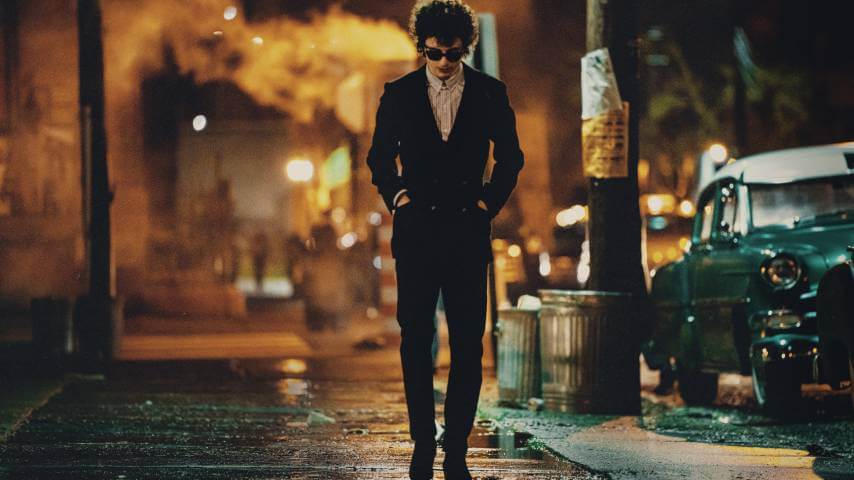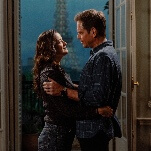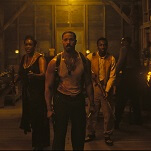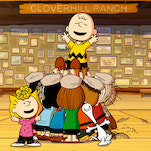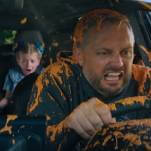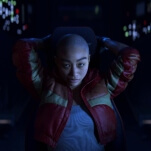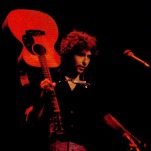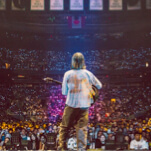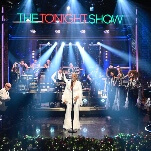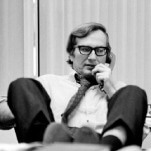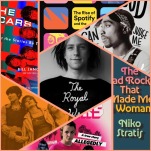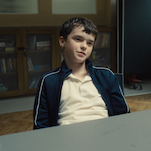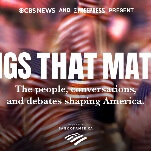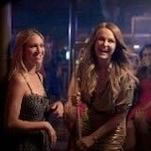People often have difficulty trying to discern, specifically, what Bob Dylan is “saying” about any given point in time. This is a self-imposed and self-limiting problem. Time and time again, the artist himself is insistent that he’s not saying anything in particular. This isn’t exactly true. He is getting at something, but—being a poet—he’s more interested in investigating, in experiencing, than in being clear in a manner that would neatly align with any given political cause. Saying simply that “the times they are a-changin’” fits nicely into the message of the big-umbrella, hand-holding, up-currenting counterculture of the Folk Revival, but it’s also not saying anything particularly profound. In fact, what makes the song interesting as a cultural touchstone—and how it fits into the Cold War, post-Kennedy assassination, Great American Wake-Up Call that any postwar optimism had been murdered in cold blood—is that it’s a simple admission that something is happening, that the culturally expanding but past-obsessed folk movement needs to acknowledge that the world is, in fact, still spinning.
This is the participatory nature of Dylan’s songs, which is no doubt a part of his appeal. He often writes in the second person, and is constantly asking questions: ”How many roads must a man walk down?” “How does it feel?” “Do you, Mr. Jones?” or my favorite, “Ain’t it just like the night to play tricks when you’re tryin’ to be so quiet?” In doing so, Dylan’s songs tend to have a less literal, direct meaning or universal interpretation, and instead speak as much (if not more) to what the person listening believes as what the artist does. I’m Not There tries to invite this formally in its casting, where the different actors are naturally going to bring their personal interpretations of Dylan to the roles they play. A part of why A Complete Unknown seems to be failing with Dylan’s devotees is that it rejects this in favor of a straightforward, Hollywood biopic narrative, the very kind that filmmaker James Mangold crystallized 20 years ago with his Johnny Cash hagiography, Walk The Line.
If there had been a problem with narratives around Bob Dylan becoming too enamored with the historic appeal of his early New York days, A Complete Unknown cements the years from 1961 to 1965 as perfect legend wrapped in a neat Hollywood bow. Chalamet’s Dylan pops in on a sickly Woody Guthrie (Scoot McNairy), and Pete Seeger (Edward Norton) encourages Bob to play for him (and of course he plays “Song To Woody”). They can’t believe it: the kid has something! Everyone is taken by the young unknown in the same way, he’s constantly mumbling out bits of what would become his most famous hits, and women are always smitten. The gleam in their eyes fades every once and a while and, as if he was Larry David in an episode of Curb Your Enthusiasm, people occasionally will stop to tell him, “You’re a real asshole, you know that, Bob?”
Chalamet’s natural swagger and cocksureness play well under the karaoke he’s doing, masking his usually fatal case of Xbox-face and allowing him to both show off in the role and show off more broadly as a charismatic star—which, frankly, is quite Dylanesque. But the Hollywood boundaries start to show their limits when romance gets involved. There’s a love triangle central to the narrative, where Dylan is pulled one way by his activist girlfriend Sylvie (Elle Fanning) and another by the beautiful and alluring Joan Baez (Monica Barbaro). Baez’s ridiculous talent, free-flowing artist lifestyle, and outright beauty comes between them—whenever Sylvie is forced to watch Bob and Joan on stage, their incredible chemistry always brings her to jealous tears.
There are a couple issues here, the first being that while Dylan and Baez are both very attractive, their romance wouldn’t be very sexy if simply transposed to screen (and often when the two have been together in documentary footage, it’s more sad how Dylan treats her, compared to Bob’s disaffection in the film and Joan’s feelings being too explosive). These were two very strange individuals, whose appeal often came from how they defied convention, not in how they fell into traditional beauty standards or hot-and-heavy romance. Another serious omission is that this love triangle is lengthened all the way out to the climactic showdown at Newport Folk Festival in 1965. Bob Dylan was already in his relationship with Sara Lownds, who would become his wife of nine years and arguably the most important muse to his songwriting. A late introduction to a new key chapter wouldn’t be a tidy way to play the film, and since Sylvie is already a character moving into fiction territory (she’s based on Suze Rotolo, but, according to Mangold, Dylan asked them to not use her real name), so why not have her hop on the back of Bob’s bike and ride up to Newport with him?
Mangold is trying to state a clear-cut thesis about Bob Dylan, which surely will help sell A Complete Unknown better than I’m Not There’s limp box office results. Mangold is saying that Bob Dylan is his own man, always on the fringes, even when it’s not popular, because ultimately he’s ahead of his time. And he plays similar beats to how Dylan’s legend has been done before. The closing acoustic of “It’s All Over Now, Baby Blue,” to the Newport audience that had just booed him off the stage moments ago, acts similarly to the moment where Dylan plays that song for Donovan in Dont Look Back—one can see the look on Donovan’s face, dejected, knowing that he’s not Dylan, that Dylan is ushering in something new that he can’t keep up with. The audience at Newport ’65 are told this in A Complete Unknown the same way they were in real life, much as the opening of the electric set with “Maggie’s Farm” tells everyone that Bob Dylan ain’t gonna to be doing what anybody tells him no more.
What this ultimately shows is that the best person to orchestrate the story of Bob Dylan’s life and work is…Bob Dylan. He’s an incredibly aware artist, and even his playing dumb has him moving constantly in friction with what people expect. Take the way he compiles Eat The Document, a documentary also shot by Pennebaker on a tour of England, but a year after Dont Look Back and under the direction of Dylan. Eat The Document is frantic, volatile, constantly making fun of itself as much as it is being outright hostile to the film’s and Dylan’s audiences. Where Dont Look Back sits and lingers as events unfold around it, Eat The Document is happy to cut back and forth between interviews and the visceral rush of a train cutting through the countryside. Dont Look Back is a film about Bob Dylan and his music, Eat The Document is a film that Bob Dylan plays like his music.
There is really no way to make a Hollywood film that would be faithful to Dylan’s work; I’m Not There is probably the closest that anything like that could get, but its lackluster reception left it waffling as a cultural product. A Complete Unknown doesn’t really try to work within the logic of Dylan. Instead, it chooses to merely lionize a great artist, which isn’t necessarily a bad thing—many will surely become interested in one of the best musicians of the 20th century for the first time because of it. It’s an introductory text, fine enough as a work of craft by a more-than-competent journeyman, that doesn’t do justice to Dylan in either his greatness or complications. But who could, besides Dylan himself?
